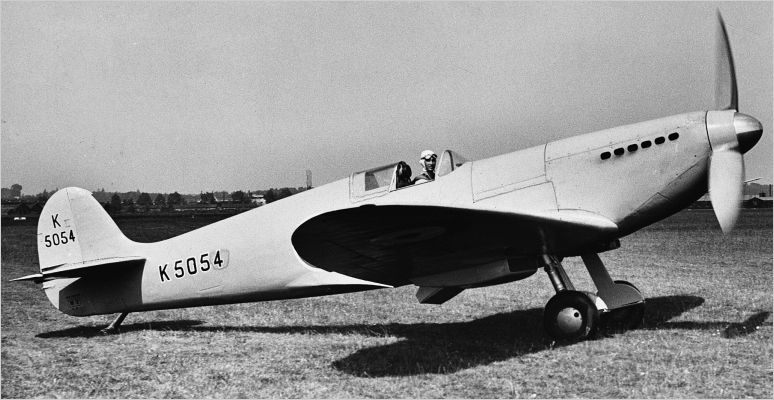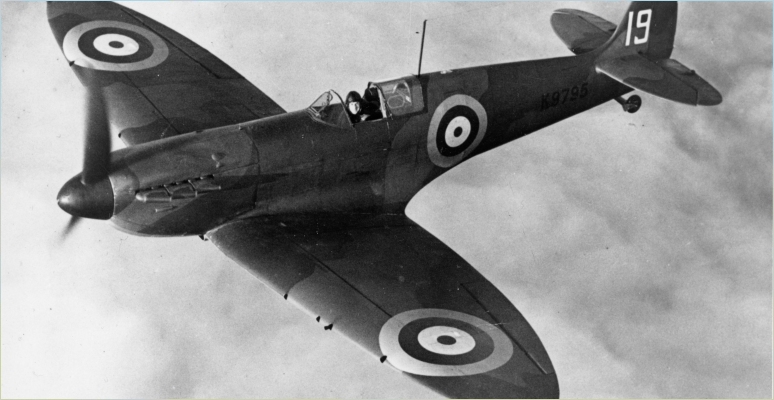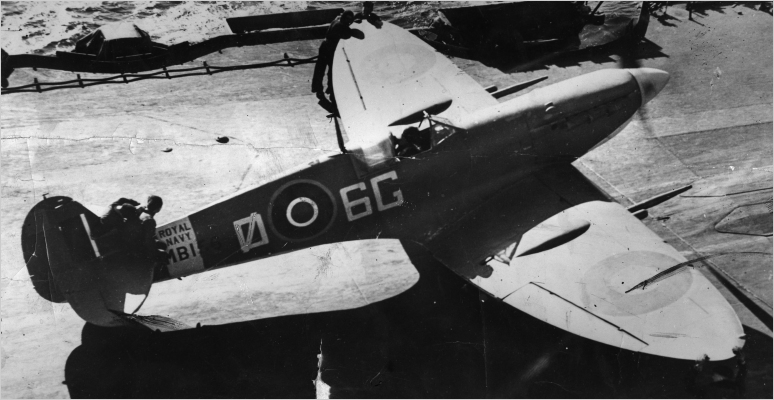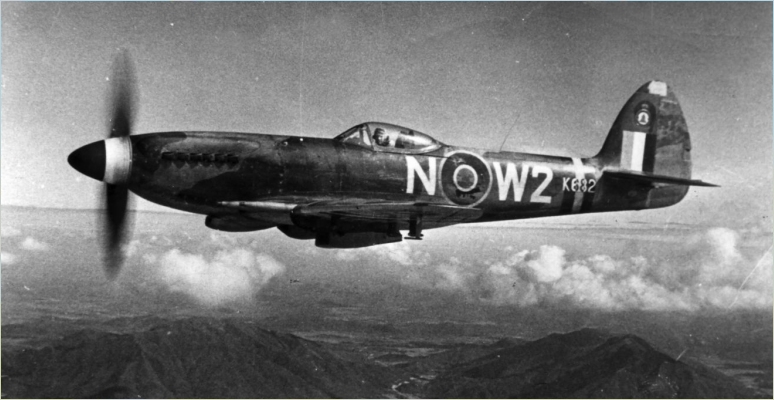| Bringing Vintage Aircraft to Life since 2010 |
|
|
 |
|
|
|
One of the most famous aircraft ever built and an icon of the Battle of Britain, the Spitfire had a long and varied history during its operational service with the Royal Air Force, which it still flies with today as part of the Battle of Britain Memorial Flight. Find out 25 Spitfire facts about the aircraft and the people behind it. Design Team Led by Reginald Joseph MitchellBorn in Talke, Staffordshire on the 20th May 1895, Reginald Joseph Mitchell joined Supermarine in 1916. During his time at Supermarine, many as chief designer, Mitchell would be involved in the design of twenty four aircraft. Although it is the Spitfire he is most remembered for he also played a role in the Walrus and Stranraer flying boats. Both of these aircraft would also serve during the Second World War (1939 – 1945). Reginald Joseph Mitchell died of cancer, at the age of 42, on the 11th June 1937. Supermarine Type 224 The Type 224 was designed in response to Specification F.7/30 which had been issued by the Air Ministry in October 1931. Featuring fixed undercarriage and gull wings the aircraft flew for the first time on the 19th February 1934. It proved unsuccessful and only one example was built, but the data and experience gained during the development of the aircraft helped in the design of the Spitfire. First Flight The 5th March 1936 saw the Spitfire prototype (K5054), still known then as the Supermarine Type 300, fly for the first time. With a 900-hp Rolls-Royce Merlin 'C' engine powering the aircraft as it flew from what was then RAF Eastleigh , now Southampton Airport, with Vickers Supermarine test pilot Captain Joseph Summers at the controls for the eight minute flight. Don't Touch Myth “Don't touch anything” was said by Captain Joseph Summers at the end of the prototype's first flight. This was not because the Spitfire was perfect but because he was to fly the prototype again later and it was set up how he wanted it. Joseph Smith After the death of Reginald Joseph Mitchell, development of the Spitfire would be headed up by Joseph Smith. Born on the 25th May 1897, Smith, who had been working under Mitchell, would be involved with all variants of the type. Joseph Smith died on the 20th February 1956 aged 58. 
Spitfire Prototype (K5054) © Wingleader Archive
Entered Service The Spitfire began to enter Royal Air Force service on the 4th August 1938 when No. 19 Squadron, RAF Duxford took delivery of the first Mk IA (K9789). These would be a fry cry from the Gloster Gauntlet biplanes they were using at the time. High Speed Spitfire A converted Mk I (K9834) fitted with a 2,160-hp Rolls-Royce Merlin 3M engine was to try and beat the air speed record of 440.68 mph set on the 23rd October 1934 by Francesco Agello in a Macchi M.C. 72. Known as the High Speed Spitfire (N.17) it would never make an attempt as before it was ready the Heinkel He 100 V8 reached 463.91 mph (30th March 1939) and then the Messerschmitt Me 209 V1 achieved a speed of 469.22 mph (28th April 1939) and put the record out of its reach. It would be converted to a PR Mk I then a PR Mk II serving in the photo reconnaissance role for the duration of the Second World War. First Aerial Victory Over Britain of the Second World War No. 602 Squadron Spitfires flown by Flight Lieutenant George Pinkerton and Flying Officer Archie McKellar intercepted a Junkers Ju 88 over the Firth of Forth on the 16th October 1939 and although both pilots attacked the aircraft the victory was given to Flight Lieutenant Pinkerton. Nearby that same day a Spitfire of No. 603 Squadron flown by Flight Lieutenant Pat Gifford also shot down a Ju 88. These would be the first German aircraft shot down during the Second World War over Britain and to be shot down by the Spitfire. Spitfires in France During 1939 One Spitfire PR Mk IA would be sent to France during November 1939, followed by a Spitfire PR Mk IB. Both would only be used for reconnaissance duties as part of the 'Special Survey Flight'. They undertook their first successful operational sortie on the 22nd November 1939, when the Spitfire PR Mk IA, flown by Flight Lieutenant Maurice Longbottom, flying from Coulommiers, France, photographs Eupen-Elsenborn, Belgium. These would have the distinction of being the first Spitfires to serve overseas. Spitfire vs Messerschmitt Bf 109 The Spitfire Mk I and Bf 109E had their first combat engagement on the 23rd May 1940. This saw Nos. 54 and 74 Squadron engage Messerschmitt Bf 109Es of I./JG 27. 
Spitfire Mk I (K9795) of No. 19 Squadron in 1938 © Wingleader Archive
Presentation Spitfires As the aircraft began to enter public consciousness, May 1940 saw the creation of 'Spitfire Funds'. From a single rivet costing sixpence to a whole aircraft at £5,000, although the true cost of a Spitfire was more. Everyone from the public to businesses could donate, and if you could afford a whole Spitfire, you could dedicate it, such as Lloyds Bank, who named theirs 'The Black Horse'. In total, around 13 million pounds was raised at the time. Highest Aerial Battle of the Second World War Taking-off from RAF Northholt on the 12th September 1942 a Special Service (High Altitude) Flight Spitfire Mk IX (BS273) was vectored to the skies above Southampton. It would end up in an engagement with a Junkers Ju 86R at 43,000 ft, the highest aerial battle of the war. First Jet Aircraft Victory When the Messerschmitt Me 262 entered service with the Luftwaffe during 1944 it was the first jet fighter to enter operational service. When a Spitfire Mk IX of No. 401 Squadron, Royal Canadian Air Force shot one down on the 5th October that same year it was the first aerial victory by an Allied piston-engined aircraft over a Luftwaffe jet aircraft. Top British RAF Ace of the Second World War With 38 victories, including 14 Messerschmitt Bf 109s and 20 Focke-Wulf Fw 190s, James Edgar 'Johnnie' Johnson would end the war as the Royal Air Force's top scoring British pilot. He would score all his victories in four different Spitfire variants. Mk I, Mk II, Mk V and Mk IX. Pink Spitfires During the Second World War a number of photo reconnaissance Spitfires were painted in light pink. These would operate mainly at dawn and dusk to blend in with the clouds at this time, flying just underneath them. This colour made the aircraft harder to spot from the ground but had the opposite effect when looking down on the Spitfire from above, making it easier for enemy aircraft to spot it. 
Spitfire Mk VB (BM590) of No. 121 Squadron © Wingleader Archive
Beer Delivery After the invasion of France during June 1944 it was difficult for Allied service personnel to get hold of luxuries such as beer. As a result some Spitfires were modified to hold beer kegs in their underwing pylons, normally used for bombs, or had their external fuel tanks converted to hold beer, and unofficially known as the Spitfire Mk XXX. Due to the cold air at altitude if the pilot flew high enough the beer was ready to serve on landing. Naval Spitfire Entering service with the Royal Navy's Fleet Air Arm on the 15th June 1942, the Supermarine Seafire, as the naval version was known, would remain in service with the Fleet Air Arm until the 23rd November 1954, when No. 764 Naval Air Squadron, who were using the type, disbanded. During its time in service, the Seafire would take part in one of the last dogfights of the Second World War on the 15th August 1945 and would see combat during the Korean War (1950 – 1953). Supermarine Spiteful During June 1944 a Spitfire Mk XIV fitted with a laminar flow wing made its first flight. This new aircraft, to be known as the Spiteful, was intended as a successor for the Spitfire. However the advent of the jet age and the aircraft's less than expected performance meant it would never enter operational service. Spitfire Users A total of 33 air forces would use the aircraft, this included the United States, who received approximately 600 Spitfires, and the Soviet Air Force, who had 1,331 delivered to them, who used them during the Second World War. Post-war a small number were used for photo reconnaissance and as fighters by the Royal Danish Air Force and the Swedish Air Force used them only in the photo reconnaissance role. MesserSpit After making a forced landing in Jersey Spitfire Mk VB (EN830) flown by Pilot Officer Bernard Scheidhauer, No. 131 Squadron was repaired and fitted with a Daimler-Benz DB 605A engine by the Luftwaffe. It would then undergo comparison tests against a Bf 109G which was powered by the same engine. No details of the tests are known. 
Seafire Mk IIC (MB156) © Wingleader Archive
Total Built 20,334 Spitfires would be built. The first was a Spitfire Mk IA (K9787) which made its maiden flight on the 14th May 1938 fitted with a 1,030-hp Rolls-Royce Merlin II engine. This was serving with a Photographic Reconnaissance Unit when it was lost on an operation on the 30th June 1941. The last production version would be a Spitfire F.24 (VN496) and this made its first flight on the 24th February 1948 and was powered by a Rolls-Royce Griffon engine, this would be struck off charge on the 15th December 1950. Highest Spitfire Flight On the 5th February 1952 a No. 81 Squadron Spitfire Mk XIX piloted by Flight Lieutenant Edward Powles was undertaking metrological reconnaissance when it reached a height of 51,550 ft whilst over Hong Kong. Last Operational Sortie The last operational sortie by a Spitfire was made by a No. 81 Squadron, RAF Seletar Spitfire PR XIX (PS888) on the 1st April 1954, with 'The Last' painted on one side of the engine cover. This aircraft was then sold to the Royal Thai Air Force two months later. Last RAF Spitfire Flight Serving with the RAF Temperature and Humidity Flight, RAF Woodvale it would be Spitfire PR Mk XIX (PS853), which was civilian operated, that made the last flight by a Spitfire whilst in active service with the Royal Air Force when it performed its last sortie on the 10th June 1957. This aircraft is still flying today with the RAF Battle of Britain Memorial Flight. Spitfire vs Lightning During 1963 Spitfire PR Mk XIX (PS853) would be used in trials against the English Electric Lightning to help Lightning pilots develop combat tactics against piston-engined aircraft. This was because the Lightning may have been involved in combat against Indonesian Air Force North American P-51 Mustangs during the Indonesia – Malaysia Confrontation (1963 – 1966). 
Spitfire F.24 (PK682) of No. 80 Squadron in August 1950 © Wingleader Archive
< Back to articles |
|
|
|
||||||||||||||
|